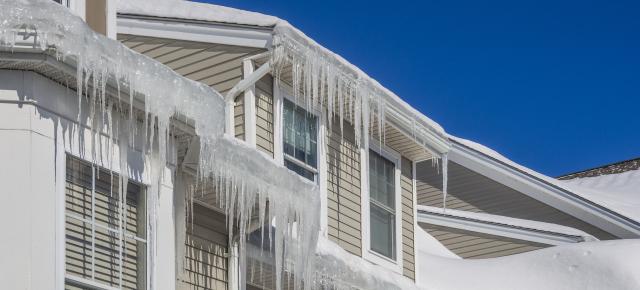Prevent Roof Ice Dam Claims
An ice dam can damage your property and result in significant costs to your business. Ice damming insurance can help with potential costs but following the tips below can avoid ice dams all-together.
A roof ice dam forms when heat rises from a building, causing the snow and ice to melt. The water runs down the roof and re-freezes when it hits a cold spot, creating a ridge of ice. This dam prevents other water from draining, which may backup under shingles and cause extensive damage inside the building.
Ice dams are caused by improper insulation, ventilation and the design of a roof.
Tips to Preventing Ice Dam Insurance Claims
- Maintain your roof surface at ambient outdoor temperature. This is achieved through sufficient insulation and proper ventilation from the soffits to the roof ridge vents. Individual roof vents should be installed within a few feet of the ridge and can be easily installed to an existing roof.
- Build a roof that would resist leaking if an ice dam forms. Install waterproof underlayment which consists of an extra layer of protection installed along the eaves (at least 36” up the roof, or more depending on your local building code), valleys, skylights, chimneys and other roof areas that seal around nails and staples under the roof material.
- If using heat tape, have it installed and maintained by a qualified professional. Over time, heat tape can cause shingles to become brittle, create a fire risk, and leak water through loose fasteners.
- When using a roof rake, it is recommended to do so within 24 hours of snowfall to more easily remove the snow from the roof. Be careful of your surroundings and physical limitations such as electrical lines and the length of the roof rake. Always follow a manufacturer’s instructions, otherwise, hire a qualified contractor.
- Shoveling snow off a roof is dangerous and could also result in damage to your roofing materials. Removing snow this way is not recommended. If you have no choice, hire a qualified and properly insured contractor to perform the task.
Submitting a Claim to GNY
To submit a claim after a winter-related loss refer to the guides here.
This material is informational only. It is not intended to be, and is not in fact, a statement, in whole or in part, of GNY’s underwriting guidelines. Nothing said here amends or affects the interpretation, application, or both, of the coverage provisions in any GNY insurance policy; nor do the statements made here constitute a representation that insurance coverage exists for any loss under any GNY policy. Coverage depends on facts and circumstances of each individual claim or loss, the applicable laws, and the policy provisions in the GNY insurance policy.
